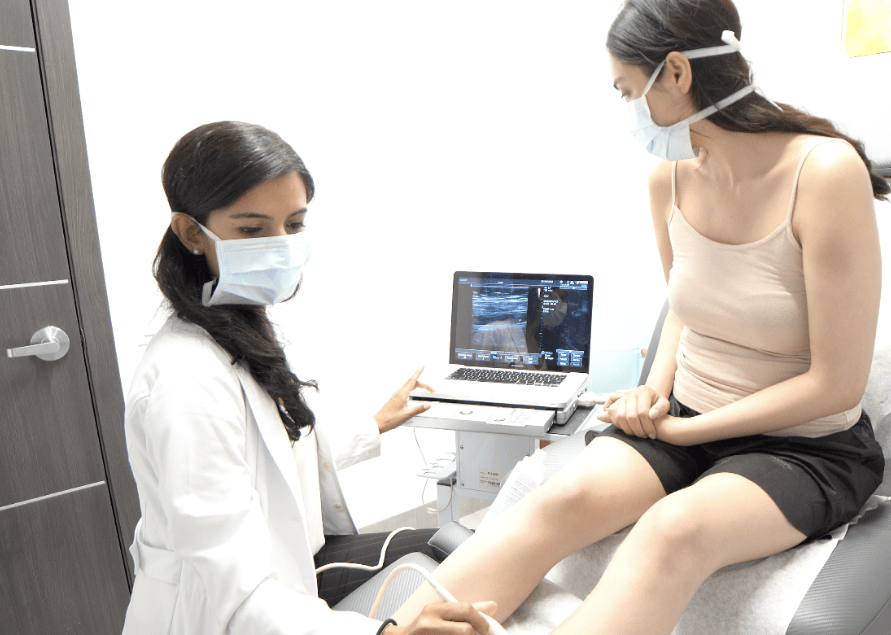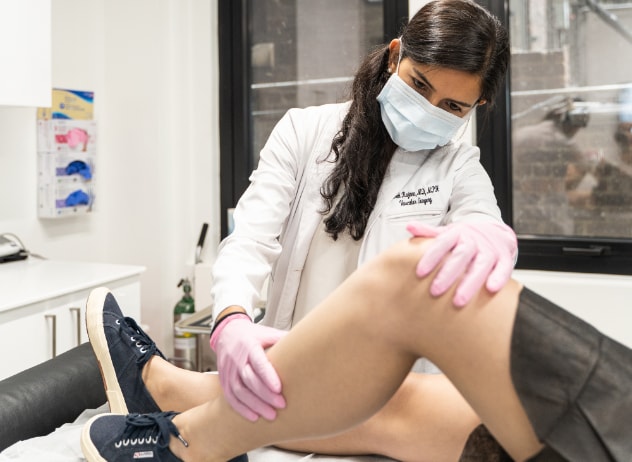Step 1: Initial Consultation
Your comprehensive spider vein treatment in Midtown Manhattan starts with an initial consultation. You can schedule a consultation at our vein treatment center online or call us at +1 646-859-1833. Our state-of-the-art facility is incredibly easy to find — it’s located at 290 Madison Ave Suite 202, a short walk from the Grand Central Station and Penn Station.
The primary goal of the initial consultation is to determine if your spider veins are caused by underlying venous insufficiency. Venous insufficiency is a medical condition wherein the collapse of your vein valves makes blood accumulate in your leg veins, leading to dilated veins that appear on the skin’s surface as varicose veins and spider veins.

Most medical spas and inexperienced vein doctors perform spider vein removal without an investigation. Consequently, the spider veins return later because the underlying disease hasn’t been addressed. Our vein treatment center favors holistic vein treatments that address the root cause of your spider veins, ensuring optimal and lasting results. The consultation at VTC Midtown includes a visual examination, medical history discussion, and vascular imaging.
Visual Examination
The vein doctor examines your unsightly leg veins, varicose veins, and spider veins to identify the signs and symptoms of vein disease. They’ll also discuss your symptoms, asking you if you experience leg pain, leg swelling, frequent leg cramps, restless leg syndrome, or other common symptoms of venous insufficiency.

Medical History
The vein doctor will also review your medical history and discuss your family’s history of vein problems. People with a history of deep vein thrombosis or a family history of vein problems are far more likely to experience venous insufficiency. Reviewing your medical history also helps the vein doctors identify the ideal treatments for you.
Vascular Imaging
Vascular imaging tests, like Duplex Ultrasound, visualize the direction of the blood flow in your leg veins on a computer screen. If you have backward blood circulation or accumulated blood in your leg veins, those are clear signs of venous insufficiency. Vascular imaging also reveals the diseased saphenous vein responsible for your vein problems.
Step 2: Treatment Plan
The vein doctor curates a minimally invasive vein treatment plan. However, instead of following a cookie-cutter vein treatment template, they discuss your vein treatment options to find the ideal procedure for you. The ideal vein treatment depends on your medical history, diagnostic results, cosmetic concerns, goals, and lifestyle. The board-certified vein doctor also discusses your insurance coverage options to help optimize your coverage, recommending treatments that lower your out-of-pocket financial burden.
Step 3: Primary Vein Treatment
The primary vein treatment includes radiofrequency ablation, endovenous laser ablation, or VenaSeal. These are minimally invasive vein treatments that close or seal the diseased saphenous vein responsible for your varicose veins and spider veins, i.e., they treat chronic venous insufficiency. As such, they’re only meant for people with vein disease. The procedures are non-surgical and conclude within an hour with no downtime.
Radiofrequency Ablation
The vein doctor makes a small incision on the skin’s surface to insert a catheter under ultrasound guidance. The catheter is driven into the diseased saphenous vein responsible for your vein problems. The vein doctor administers local anesthesia to the diseased vein’s walls, protecting the surrounding tissues. When activated, the catheter generates radiofrequency waves that destroy the diseased vein, rerouting the accumulated blood to healthier leg veins.
Endovenous Laser Ablation
The vein doctor makes a small incision on the skin’s surface to insert a laser fiber under ultrasound guidance. The laser fiber is driven into the diseased saphenous vein. The vein specialist delivers local anesthesia into the diseased vein’s walls. When activated, the endovenous laser destroys the problematic vein, rerouting the accumulated blood to healthier leg veins. This procedure causes a little more post-procedural discomfort than radiofrequency ablation.
VenaSeal
VenaSeal is an FDA-approved medical adhesive used to treat venous insufficiency. The vein doctor injects the vein glue into the diseased vein under ultrasound guidance. The diseased vein’s walls seal shut, rerouting the accumulated blood to healthier veins. Over time, the saphenous vein hardens into scar tissue that gets absorbed by the body.
Step 4: Cosmetic Vein Treatment
The cosmetic vein treatment includes ambulatory phlebectomy for the superficial varicose veins and sclerotherapy for the spider veins. These procedures are suitable for patients without underlying venous insufficiency or follow-up to the primary vein treatment. They’re non-surgical and minimally-invasive procedures that conclude within an hour with no downtime.
Ambulatory Phlebectomy
Ambulatory phlebectomy is a minimally invasive treatment for superficial varicose veins. The vein doctor makes small incisions on the skin’s surface to physically remove the varicose veins from your legs. The incision marks gradually heal into scars that eventually fade away.
Sclerotherapy
Sclerotherapy is a minimally invasive spider vein treatment. The vein specialist injects a medicine called sclerosant into the spider veins to fuse their walls, turning them into hardened scar tissues that fade away from the skin’s surface. You may need multiple sclerotherapy sessions for optimal results.
Step 5: Post-Treatment Recovery
The minimally invasive vein treatments conclude in 30 to 60 minutes, following which you can resume your daily activities. The vein doctor provides a list of post-treatment recovery guidelines to ensure optimal recovery, such as wearing compression stockings, avoiding heavy lifting, and engaging in cardiovascular activities, like running, swimming, and cycling. Since there’s no downtime, you can resume your normal work immediately after the vein treatment.









